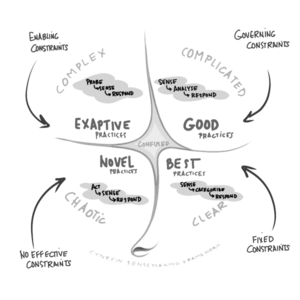Constraints
Framework
While we often focus on the collective behaviors of a system, the "constraints" of that system inform and shape that behavior. Constraints shape a system by modifying its phase space (its range of possible actions) or the probability distribution (the likelihood) of events and movements within that space. Because constraints are both key actors and key indicators of a system, constraint mapping can be a highly productive first step in considering how to intervene.
Constraints come in many forms and there are many ways to categorize them. Gatlin (1972)[1] and Juarrero (1999)[2] both describe two primary categories: context-free constraints, which behave consistently across the system, and context-sensitive constraints, which vary depending on their context.
In the Cynefin framework, constraints play a key role in understanding the differences between the clear, complicated, complex, and chaotic domains.
- The Clear domain is associated with Rigid constraints
- The Complicated domain is associated with Governing constraints
- The Complex domain is associated with Enabling constraints
- The Chaotic domain is associated with the absence of constraints
While the name "constraints" implies limitation, constraints can also connect as well as limit. This is a central property of constraints, that they simultaneously close down some possibilities while opening up other ones. A completely unconstrained, fully random system is chaotic, there are no relationships between agents, and no communication is possible. The interdependence of constraints, and the effect of the constraints on interdependence, allow systemic behaviors to emerge.
Types of Constraints
There are many ways to categorize and describe constraints. The Managing Complexity (and Chaos) in Times of Crisis describes the following types. Note these should not be seen as exclusive but complementary in a number of cases, for example governing constraints in the Clear domain are also likely to highly rigid and have low permeability.
Governing/Enabling Constraints
Laws, rules, and codes create governing constraints. They give a sense of stability but are sensitive to change. Heuristics and principles, on the other side, provide guidance while allowing for distributed decision-making. Mining the organisation's narratives for examples of heuristics that have evolved over time, based on expertise and experience, is a key audit process. They are then consolidated, codified in memorable form, and associated with teaching stories for rapid distribution. Measurability of compliance and a focus on concrete are key, abstract platitudes don’t work.
Internal/External Constraints
Insects have exo-skeletons which limit the size to which they can grow but provide a clearly visible structure; mammals have an endo-skeleton which makes them all self-similar but with a wider variety and fewer limitations on growth. Organisation design tends to focus on creating a skeleton, or scaffolding, and ‘points of coherence’ around which unities interact with each other and with the scaffolding itself. This is the case of ritualized meetings, performance evaluations, career assessments, etc. As far as external boundaries think markets, resources, social foundations, and environmental ceilings.
Connecting/Containing Constraints
Connections, like hashtags in knowledge management and links in networks, provide a flexible and adaptive structure but at the cost of visibility and control. Containers, like categories, spreadsheets cells, and departments, provide clear, reassuring boundary conditions. Changing connections between people and organisational units is less costly than trying to restructure or reorganize departments. As new connections start to provide new ways of dealing with issues, then the constraints can be tightened and eventually formalized into new units and departments.
Rigid/Flexible/Permeable Constraints
Deadlines are an example of constraints that are usually intended to be rigid. Flexi-time is a malleable way to manage attendance at work. Rigid structures resist until their design conditions are exceeded at which point they break catastrophically. In contrast, flexible structures adapt to stress and conditions of constant change. Rigid and flexible boundaries increase their resilience with permeability or special conditions that allow for exceptions, but permeability brings the possibility of clogs, i.e. too many people applying for or expecting exceptions.
Dark Constraints
A reference to dark energy or dark matter: we can see the effect of a constraint but we don’t know the cause. Dark constraints are like the several hidden meanings a term can assume for different people. When we mention a term and we see different reactions, we see dark constraints at work. Narratives are powerful antidotes against dark constraints. We can also get a sense of the risk going forward by modeling how much of the past we can explain by the constraints we are aware of. The more we can’t explain the less we can monitor, the more likely unexpected and potentially catastrophic surprise.
Common Misunderstandings
Constraints in Cynefin® are not the same as Constraints in Theory of Constraints (TOC). In TOC you manage the constraints to improve the throughput of the system whereas in Cynefin® you bias a system with constraints. There was an exploratory on that topic which Steve Holt summarised here.
Core theory
Gatlin explores constraints in a biological context in Information and Living System while Juarrero explores constraints from a philosophical perspective in Dynamics in Action. Juarrero provides the 'scaffolding' for Cynefin in this work.
Supporting artefacts
References
Articles
Blog Posts
- Dave Snowden, Cynefin St David’s 2022 (2 of 2), The Cynefin Company Blog (Mar 2, 2022), explaining the existing conceptual relationships between constraints and scaffolds, and Cynefin domains.
- Dave Snowden, Finding the right language, Cognitive Edge Blog (December 22, 2021), quotes dialogue with Alicia Juarrero in which the complexity theory concept of constraint is contrasted with Goldratt's Theory of Constraints
- "Returning to constraints," Dave Snowden, Cognitive Edge blog, December 21, 2020
- "The knotty issue of constraints,"Dave Snowden, Cognitive Edge blog, August 27, 2017
- Yes but… (and the Isaiah moment is still with us), Dave Snowden, Cognitive Edge blog. 30th August 2017
- "Dark constraints," Dave Snowden, Cognitive Edge blog, December 11, 2016
- "Constrains that enable innovation (video)," Alicia Juarrero, Lean UX NYC, April 16, 2015
- Patterns and constraints, Chris Corrigan, September 2020.
Related concepts
Cases and Citations
Link to case articles here or third party material
